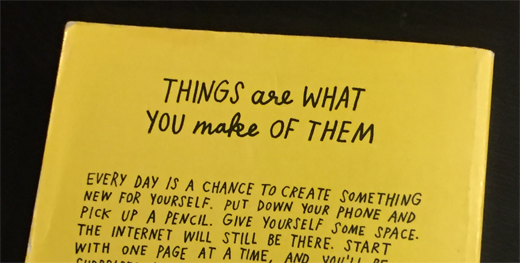About My Deconstructions
When I started writing here at The Hot Iron, the name came from the expression, “strike while the iron is hot.” Though my entry into the world of blogging could be considered more functional than creative, taking burning topics – whether business, technology or personal – and boiling them down was far from anything new to me.
Much thought has gone into the direction of my blog lately, which is one aspect of the thought into my greater self. As I have considered the focus on what I write, I have also focused on how I write, namely in the approach I take with covering a topic. The product of this quest is what I am calling My Deconstructions.
What is a deconstruction? As I write here and elsewhere, I will strive to take my analysis and reporting on a topic and conclude it by breaking it down into essential points and conclusions. In some regards it will be similar to my book takeaways; rather than rating a book I share what I gained from the time spent reading it. In some cases it is a summary, and in others I look back on something I took from it and am surprised I came up with it! The deconstruction may be takeaways, action items, next steps, essential components, revelations or something else I haven't thought of a category for.
Like anything, I have already started writing these and will see how it evolves. As a reader, whether your first time or as a long-time one (and I know there's a few of you out there), I welcome your thoughts and feedback as this new approach appears in my future posts.
Deconstructing Deconstructions
Why shouldn't what I write about deconstructions have one itself? As time is always of the essence, taking the time to make or reiterate the main points from something is always useful to whoever is consuming it. It also helps the reader understand your main points, as you never want to assume someone has gleaned them from reading your work. In the end the reader – you – will say if these deconstructions are helpful, and please let me know in the comments to this post either way.
This is from The Hot Iron, a journal on business and technology by Mike Maddaloni.
Did you enjoy this? Subscribe to The Hot Iron by RSS/XML feed or Read by Email.
Announcements • Business • Strategize • (0) Comments • Permalink
My Takeaways So Far From The Book 1 Page At A Time
A consequence of being in a routine is that our entire body can be consumed by it. Where things like repetitive strain injuries or simply being sore from sitting on our butt for a long time are obvious, what isn’t as apparent is the impact on our brain.
If you don’t believe me, here’s an example – you are buzzing along in what you do all day and someone comes along and asks you a question, and all you can do is stare back dumbfounded. They may have well as used a Sharpie and wrote it on a pool noodle and hit you with it. Call it brain fatigue, but does it show a sign your brain needs some exercising?
When I saw the book 1 Page at a Time – A Daily Creative Companion by Adam J. Kurtz sitting on the shelf at Judy Maxwell Home in Chicago, I couldn’t help but pick it up. (If you don’t know about this store, think Spencer Gifts with an old-world flair and a sharper edge; it’s also owned by actress Joan Cusack, so that adds to its eccentricity) It only took me flipping through the first few pages and I was sold. It is an adult workbook, with a page a day dedicated to a brief creative exercise to do in the book.
Each page presents a unique activity, from making a list to drawing a picture to whatever. Some are quick and easy, some require actual thought. As it’s a page a day, and I started late last year, I am not done yet – thus the “so far” in the title – but I have enjoyed every exercise so far.
Though I have much to go, I feel my takeaways from 1 Page at a Time will endure and be reinforced as I go through it.
Think Different – Borrowing from the infamous Apple tag line, this book does just that. It asks you to do things you most likely don’t normally do on a regular basis as part of your job or even for fun.
Challenge Yourself – As some of the activities have required me to sit back and ponder before putting pen to page, it’s been extremely helpful to have a challenge that is outside of my normal work and life challenges, which tend to be more technical, business and child-focused.
Draw – When was the last time you drew a picture? For the fun of it? This is probably why adult coloring books are all the rage these days. Where many of you reading this may not consider yourself an artist, the drawing I am talking about is not about being an artist. Rather, it is about expressing something with visualization.
On occasion a day or 2 go by when I don’t do a page a day, but then I catch up on them. I tend to do them in page sequential order, but there is no reason you can’t flip around and choose one at random. I never read ahead, as I like to approach these with some spontaneity.
I highly recommend getting a copy of 1 Page at a Time, or get 2 – 1 for yourself and 1 for a friend. If you have it and are using it, I’d love to hear what you think about it in the comments to this post.
This is from The Hot Iron, a journal on business and technology by Mike Maddaloni.
Did you enjoy this? Subscribe to The Hot Iron by RSS/XML feed or Read by Email.
Book Take-Aways • Business • Strategize • Thrive • (3) Comments • Permalink
7 Netflix Parental Controls I Would Love To Have
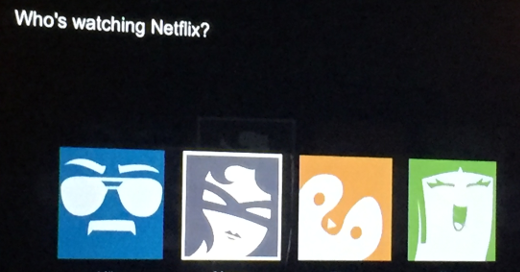
I remember when I had my first cable TV box back in the late 80's and saw a lockout switch on the back - you could select channels you wanted to block, then flip the switch in the back of the box and you couldn't tune them in. You could even put a padlock over the switch to secure it.
How I wish I had something equivalent to that for Netflix today.
The idea of parental controls for technology today - from computers to mobile devices to apps and Web sites on them - is one of interest and concern for parents. As much as we want to watch all of what our kids get into and trust them completely, neither are realistic. We can always remove the devices from their hands, but with schools using more Web and app-based educational tools, the devices will be within their reach more and more.
Going into this list, I have no illusions (delusions either) that any form of parental control functionality will be perfect. That being said, they can begin to make an impact and provide some form of management without needing to watch over their shoulders 24/7. Plus any controls are technology chasing technology and a moving target, and even these things are for right here, right now.
In somewhat of a top-down order, here;s my 7 suggested Netflix parental controls.
1. Separate Profile Passcodes – Netflix has the ability to create a unique profile for individuals who share an account. Where there is the ability to set a profile as a Kids one, there is no stopping my Thing 1 or Thing 2 from browsing Mom or Dad's profile. If each had a unique passcode (or password or PIN) then you could limit them to their own profile. Of course if they watch you enter your passcode, the idea is moot.
2. Disable Profiles – Once you lock down profiles (or at least your own), having the ability to lock or disable individual profiles is ideal. Is Junior grounded for a week but still has homework on the iPad to do? This would be a great way to keep them from getting entertained by Netflix programming.
3. Deselect Shows or Series – Don't want your princess watching Mako Mermaids until she is older? Having the ability to browse to a show or series and click a “disable” button and then show the profiles which you want to block it from will give you piece of mind.
4. Limit Number of Shows Watched – Do you have a little binge-watcher in the making? Setting a limit on the number of shows watched over a particular period of time (day, week, month) will not only limit their screen time, but will also give them some self-training in managing their own time.
5. Limit Time Watched – In addition to the number of shows watched, you could limit overall time by period as well, with an option to let them finish watching a show in progress (or not) or not even watching one longer than their set time limit.
6. Remove Search – By removing the search option within Netflix, it will limit them to browsing which may force them to watch something presented early to them. Of course search requires spelling, though it's unclear if spelling “My Little Pony” benefits their education.
7. Reporting – She watched the same Monster High movie 33 times? Having the ability to see what shows were watched – and when – is helpful in determining how to set parental controls, in essence how much of a challenge you have.
Deconstructing Netflix Parental Controls
Online streaming, or video on-demand as was called when I had that cable TV box, is prevalent today. With more people “cutting the cord” from cable TV, services like Netflix are the de facto form of entertainment for kids and adults alike. I am not talking here about auto-pilot filtering of content, rather tools being available where I can set them for my children as I see fit. And I'd be willing to pay a little more for these tools, too.
Do you think these would be helpful for you as a parent? Or for yourself too? Or do you have any other suggestions? I welcome your thoughts and ideas in the comments of this post.
This is from The Hot Iron, a journal on business and technology by Mike Maddaloni.
Did you enjoy this? Subscribe to The Hot Iron by RSS/XML feed or Read by Email.
Strategize • Technology • Web Design • (0) Comments • Permalink
2 Ways to Export Your LinkedIn Connections And Information
![]() With the news this week of Microsoft acquiring the business social media site LinkedIn for US$26.2B, the first thought I had was, “gee, when was the last time I exported my LinkedIn connections and information?”
With the news this week of Microsoft acquiring the business social media site LinkedIn for US$26.2B, the first thought I had was, “gee, when was the last time I exported my LinkedIn connections and information?”
As you read that, you may have thought, “gee, I can export my LinkedIn connections and information?” Yes you can, and if you didn't know that 1) you are not alone, as many people are unaware of this, and 2) you still can do it, and I'll show you how.
After all, they are your connections
As you have built your connections and updated your information in LinkedIn, you have compiled a wealth of data over time. For many of your connections, you may not have their business card or any other record of them outside of the site. With LinkedIn's messaging service, you may have been in communication with someone without ever sending them a regular email message. Many people also keep their LinkedIn profile more current than their resume.
With the reality of our reliance on Web services like LinkedIn, this is not surprising. Fortunately they also offer the ability to export key data – your connections and other information it has collected on you, such as your profile. If you have never done it, there's no time like the present, and here's the quick and painless steps to execute these not-so-obvious functions.
Exporting LinkedIn Connections
Whether you have a handful or 500+ connections (LinkedIn will only show you the true number you have and nobody else for some reason), you have the ability to export them. When you perform an export, key information you'll get is name, current employer and title and email address, as most everybody has this information on their own profile. Name and email is in my mind most important as you have a way to reach them.
Here's the steps to follow to export connections.
1. Log into LinkedIn using a Web browser and select Connections from the My Network menu.
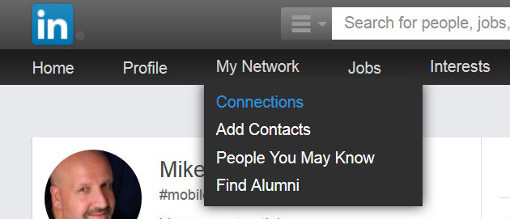
2. Click the gear icon for Settings on the right side of the screen.
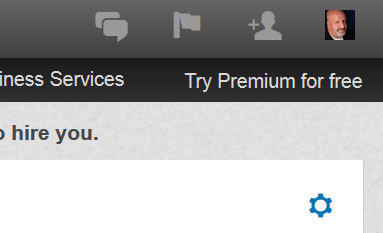
3. Click the link “Export LinkedIn Connections” on the right column on the screen.
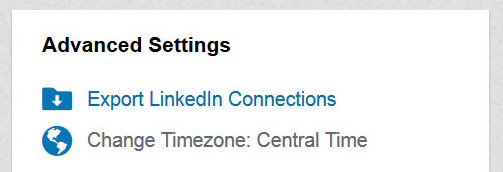
4. You have the option to select the format you want your connections in. I have always selected “Microsoft Outlook (.CSV file)” as this gives me a delimited file I can easily open in Excel or Open Office. The other formats may better suit for importing into another program or Web service. Once you select your desired format, click the Export button.
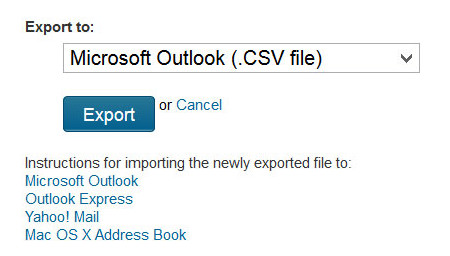
5. You will be prompted with a CAPTCHA for a “security verification” to ensure LinkedIn that you are a real human being requesting your contacts. Enter the CAPTCHA value and click the Continue button.
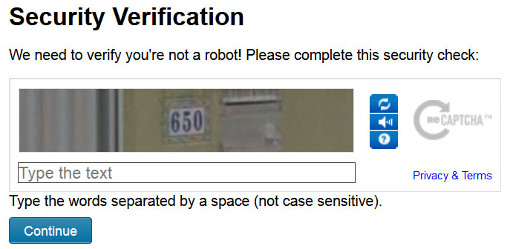
6. You will get a popup in the browser to save or open the file (the actual appearance of this will vary by browser). Make your choice, in this case I am going to save it.
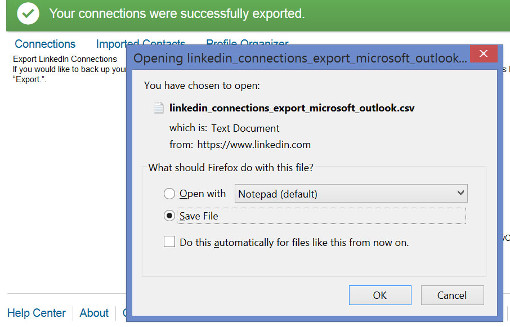
7. Open this file in Excel or your favorite spreadsheet and you can browse and process your contacts.

What you do with your contacts is of course up to you. Even if you have no immediate plan – or time – to do anything with them right now, you at least have a backup of the contacts your spent a long time curating.
Exporting LinkedIn Information
In addition to your contacts, you have profile information and activity performed on LinkedIn, such as messages, etc., which you can export as well, though you may have to wait at least 24 hours to get it. This is probably due more to load on their servers than an element of control (I hope!), but within a day you can get it all, and here's how to request and receive it.
1. Click on your picture icon at the top right of the screen and select “Privacy & Settings / Manage” from the menu.
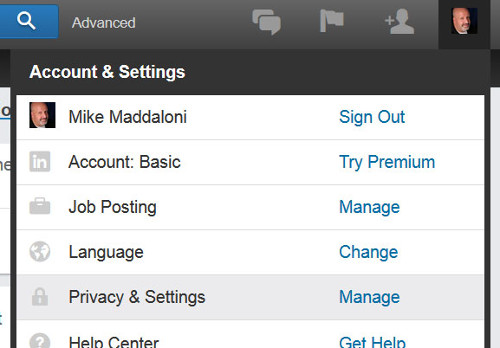
2. Scroll down the page and click the “Getting an archive of your data” link.
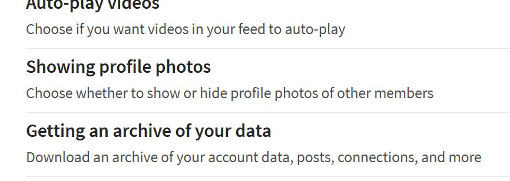
3. Click the button labeled “Download” on the right side of the screen.
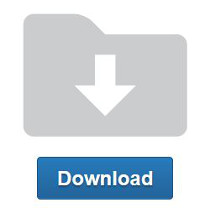
4. Wait. The message on the screen will say you will receive an email within 24 hours. In this case I got 1 email with a partial file within a short period of time, and then within a day I got a second email with a link to the entire archive of information.
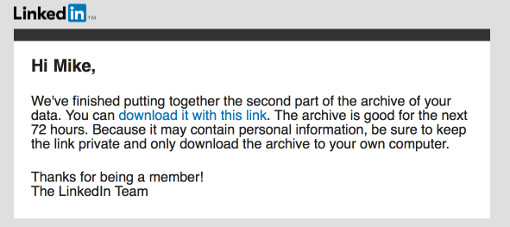
So what's in this archive Zip file? In addition to any images you have posted (your profile picture, banner, etc.) there are several delimited files in CSV format with everything from profile information to what you have searched on. Take a look!
Again, what you do with this – and when – is up to you, but it is yours, and now you have it in your digital hands.
Deconstructing Data Exporting
Since LinkedIn launched in 2003, many, including myself, assumed the service will always be there, every time we want it, as it has been. In the recent past it has added and even removed features, like Answers, where many posted a lot of information. Where it's their platform, at least they realize it is your information and make it available to you. With the unknown of the future, plus a future under Microsoft's ownership, why not get a copy of your LinkedIn information today?
This is from The Hot Iron, a journal on business and technology by Mike Maddaloni.
Did you enjoy this? Subscribe to The Hot Iron by RSS/XML feed or Read by Email.
Build • Business • Social Media • Strategize • Technology • (5) Comments • Permalink
Ridin’ Writer’s Block Out
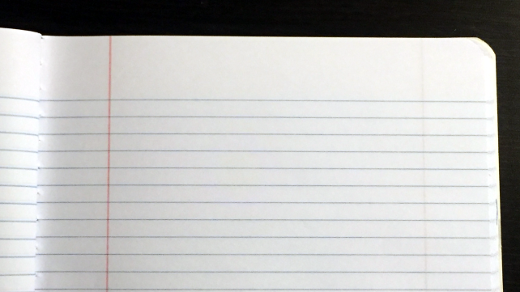
A few days ago I experienced something I never have before in my life. And looking back now, that was ok.
I had writer's block.
Over the last decade of blogging I have grown to love writing. What started out as cranking out a few paragraphs for my first dozens of posts here at The Hot Iron has grown to a passion for writing out – ok printing, but on paper – what I have sketched out and organized in my head and then type up to post. This is a similar approach I take with writing for my day job, as well as guest posts I have made on other blogs and sites.
As I write this in the first week into June of 2016, I look back and I did not post anything on the blog during the month of May, making for one of the longest recent stretches for me. Where I can say with confidence I did a lot of other things over the past month, both professionally and personally, I did not spend any “me” time to write. With that as a cloud over my head (ok, a thin cloud, but sun-blocking nonetheless) I tried to force the issue and do some writing.
A window of opportunity presented itself, with a meeting being canceled during noontime, and I saw this as my chance to get in some writing. I grabbed my notebook, pen, and headed for one of the few local Starbucks where I have written much of what I have written in the last year. After pouring a little whole milk in my grande dark roast I spotted an open seat at the tall table where I like to sit, put my stuff down, took a sip as I opened my notebook... and just stared at the blank page.
And I stared for what seemed like an eternity. I had a couple of topics to choose from, however nothing seemed to go from my brain to my hand to my pen. I even tried to go back and look at something I had started previously, and simply X'ed it out writing “trash” over it. Trying harder to focus didn't work either, as my mind was more focused on the sounds of the espresso machine and Frappuccino® blender, not to mention the people walking outside of the store. I was besides myself as I had been able to focus while sitting at this very same table where in the past the other 5 stools were occupied by police officers and I was able to tune them out! Realizing I had spent about 40 minutes and was only able to choke out not even 1 page of something I haven't looked back on yet, I closed my notebook, grabbed my coffee and made my way back to the office.
Not My Time
As I sauntered back to the office, frustration segued to reality as it came to me – this was not the time to try to write. Where everything else lined up into place – an hour of time, dark roast available brewed and not as a pour over – the one thing that was not ready was my brain. I had too many things on my mind, everything from the work I had to go back to when I returned to the office as well as everything else going on in my life. Forcing it right then and there wasn't going to change the situation, so I just needed to find another time to do it. Like right now, several days later, where the words are flowing faster than I am able to type them.
In the end I simply need to ride out writers block. And that phrase – ride out – came to me as well as I was walking back to the office, where the only real thing I was concerned with was avoiding panhandlers and other pitch people on the sidewalks. Of course my brain, which was schooled in 80's rock music, quickly dropped a needle on an old REO Speedwagon album, playing “Ridin' The Storm Out” over and over as I wrote this. However unlike the other day, the song served as an inspiration and not an impediment.
Deconstructing a Writer's Block
Over the years I certainly wouldn't say every time I sat down to write was an ideal time. This one time was the worst of them all. No beating myself up over this “lost” 40 minutes is necessary either. Had it not been for it, I wouldn't have written what you are reading now, or thought of that REO Speedwagon song, or gotten myself psyched up to write some more. The creative process can't always be controlled.
If you're not familiar with the song in my head, you can watch the video embedded below, or if you can't see it you can click on this link to view it on YouTube. Interestingly, this video was recorded on my 18th birthday.
This is from The Hot Iron, a journal on business and technology by Mike Maddaloni.
Did you enjoy this? Subscribe to The Hot Iron by RSS/XML feed or Read by Email.
Blogging • Strategize • Thrive • (5) Comments • Permalink




